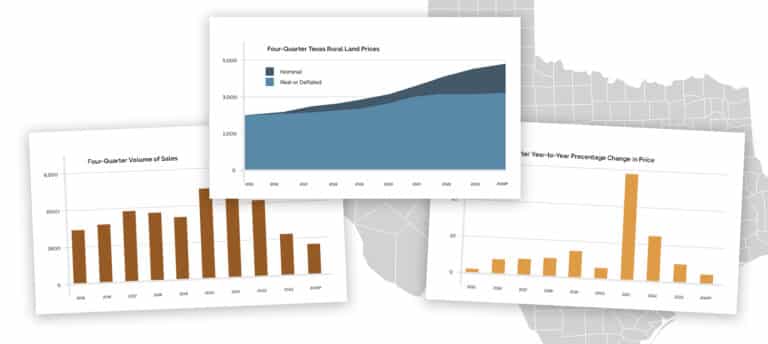As part of the Texas Wildlife Association’s 2018 Private Lands Summit, “The Border Wall: Protecting Our Country or Dividing Our Interests,” attorney Jim Bradbury presented “Condemnation Consequences,” a look at the history and application of federal eminent domain powers as they relate to the construction of a border wall. It is a federal project that has implications for landowners along the 1,200-mile Texas-Mexico border.
The lessons learned in South Texas as border wall construction proceeds is an ongoing case study of federal taking for landowners throughout the nation.
Read more: The Border Wall: Protecting Our Country or Dividing Our Interests?
The Federal Track Record
In 2007, under the direction of the Department of Homeland Security (DHS), the Army Corps of Engineers built an 18-foot fence designed to keep out drug smugglers and immigrants crossing illegally into the United States. The Department of Homeland Security filed more than 360 eminent domain lawsuits against property owners involving thousands of acres of land in Texas, New Mexico, Arizona and California.
The majority of cases were filed in the Southern District of Texas Federal Court; of the 330 filed, 90 cases were still pending as of 2017. The initial phase in Texas was constructed primarily in Cameron County.
DHS’s handling of the project prompted an investigation, which found the agency circumvented the law on fair compensation. Among other findings, the agency did not conduct formal appraisals of targeted parcels, failed to account for the value of water rights and paid some people for land they didn’t own because title searches were flawed.
Despite the investigation, the process hasn’t undergone a significant change. It appears that the federal government will be following the same pattern it established in 2007 as agencies move forward with the construction of the border wall in 2018. In March, Congress allocated approximately $1.6 billion to building this section of the wall.
In July 2018, landowners in Hidalgo County began receiving “notice for right of entry,” which is the first step in federal condemnation.
Thoughts on federal eminent domain
The Proposed Border Wall
“For the purposes of these remarks, I’m looking at this project from the perspective of a single landowner. This is going to get real for some people very quickly. Some areas are going to be spared, but for many individuals, lives are going to be turned upside down as they fall into the worst sphere of all in law, the law of taking.
No single landowner is going to change the route of this fence. When the fighting starts, landowners will be fighting for fair damage payments.”
Federal vs. State Taking
““Eminent domain at the federal level is very different than eminent domain at the state level. At the federal level, the taking is a seizure. The federal government takes the land and takes it right away; there is no long runway to losing your land.
When the federal government decides the time for negotiations is over, the agency involved files a lawsuit, deposits money in the amount their personnel has deemed appropriate and the land is theirs. From that point on, you as landowner are on the defense and fighting over how much you will get paid.”
The Toll
“Obviously, a taking has a financial burden, but the number one consequence is stress. As a landowner you can hire a lawyer to deal with the law, but you will have to walk in your back door, sit at your kitchen table and talk with your family about this—day after day. People who go through this will never be the same. And they will have to work around and stare at the wall in perpetuity.
It is daunting to see a lawsuit styled United States of America v. you. The entire weight of the Department of Justice will be brought to bear on you as they take your property—and they will get your property.
The organizations the federal government works through are not known for their care and compassion. At this moment, the Department of Justice is hiring more lawyers. These lawyers are going to come in from somewhere else and their goal will be to get this done so they can get back home.
Remember, once the federal government decides negotiations are over and it sues you, your land belongs to them, and they can begin work even though you haven’t reached an agreement. You can still be fighting with them at the courthouse and come home to watch contractors, bulldozers and the whole effort pushing ahead with the project.”

At both the state and federal levels, the Texas Wildlife Association stands on the front lines for landowners when issues and policies impact private property rights and therefore their ability to manage their land. Texas shares a 1,200-mile border with Mexico. The proposed border wall and its associated takings will affect an untold number of landowners as well as natural resources such as wildlife, water and habitat.
Statement Regarding Border Security
Texas Wildlife Association (TWA) strives to protect private property rights in balance with natural resource conservation efforts here in Texas. As such, TWA is deeply interested in the concept of a wall or physical barrier designed to secure the Texas/Mexico border.
TWA sees the urgent need for control of illegal immigration and smuggling traffic in Texas. This traffic directly affects the security of our nation and the security and well-being of landowners, ranchers and wildlife stewards in the border region. Furthermore, this traffic is massively disruptive to ranching, wildlife and land-management practices.
However, TWA is concerned that a physical barrier along the rural Texas/Mexico border would result in substantial condemnation of private property by eminent domain, interrupt landowner/livestock/wildlife access to water from the Rio Grande River, harm property values and impair critical wildlife movement corridors for species such as black bears, mountain lions, white-tailed and mule deer and desert bighorn sheep, among others.
TWA sees merit in physical barriers at strategic locations, such as metropolitan areas. TWA strongly urges the Department of Homeland Security to develop and use methods other than physical barriers along the remainder of the border. TWA believes that increased patrols, more strident enforcement of existing laws and technological monitoring of the border will achieve the worthy goal of controlling illegal border crossings while minimizing impacts to private property rights and our precious natural resources. TWA is eager to serve federal and state agencies as a resource on addressing this critical issue.
Applicable Law
U.S. Constitution 5th Amendment
“. . . nor shall private property be taken for public use without just compensation.”
Kelo v. City of New London
After approving a development project, the City of New London, Connecticut used its eminent domain powers to take away private property and sell it to private developers for the purpose of creating new jobs and increasing tax revenue. In 2005, the U.S. Supreme Court ruled the taking was Constitutional prompting 45 states, including Texas, to improve landowner protection against the capricious use of eminent domain. No meaningful reform took place on the federal level.
Declaration of Taking
40 USC § 3114
The federal government uses a “quick take” procedure that originated during the Great Depression. Upon filing the Declaration of Taking and depositing “estimated compensation” with the court, the land title passes to the government.
Relocation Assistance and Real Property Acquisition Policies Act of 1970 (Uniform Act)
This act requires government to negotiate with owners before seizing land, but there is an exception that allows agencies to bypass the law so long as it would “not reduce any assistance or protection provided to an owner.” For purposes of the 2007 fence project and the border wall, the federal government waived the Uniform Act.
Eminent Domain Procedure
Fed. R. Civ. P. 71.1
Commenced by filing of complaint, which includes the authority for the taking, the uses for which the property is to be taken, a description of the property, the interests to be acquired and a designation of each defendant who has been joined as owner or owner of an interest in the property. After being served, defendants have 21 days to answer with all objections and defenses. All objections and defenses not stated in the answer are waived.
Preparing for a Federal Taking
Some practical suggestions compiled from people whose land has been in the path of the border wall.
1) Inform Yourself. Don’t reinvent the wheel, but talk to other landowners who have already been impacted by the project. Search the Internet, but only go to original sources.
2) Analyze the Impact. Look long and hard at how the project will impact your property and your operation.
3) Work with State and Federal Officials. Get engaged. Know them. Bring it to a personal level of understanding.
4) Arrange Legal Representation. The issue is complicated. The government is represented by lawyers intent on pushing the project through on a tight timeline. Expertise is important.
5) Network with Other Affected Landowners. Power exists in numbers, information sharing and cooperation. Because of the speed and compartmentalization of this project, it is difficult to work together.
6) Join an Association. Again, power exists in numbers. Industry groups such as the Texas Wildlife Association, Texas & Southwestern Cattle Raisers and Texas Farm Bureau represent the interests of landowners at the state and federal levels on issues such as eminent domain and private property rights.
With more than 27 years of experience, Jim Bradbury maintains offices in Fort Worth and Austin. His practice specializes in eminent domain, environmental and water law. Bradbury also serves as Adjunct Professor at the Texas A&M University School of Law.


